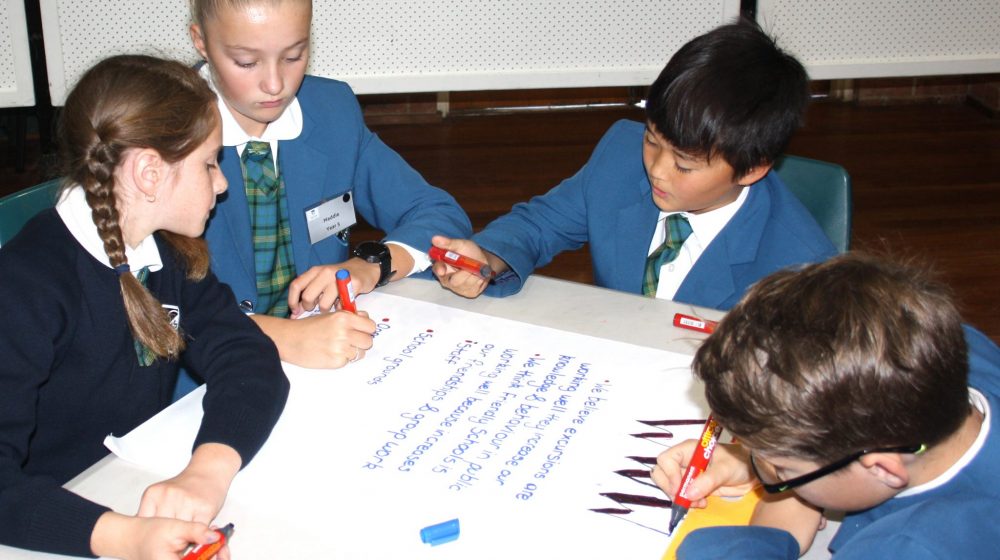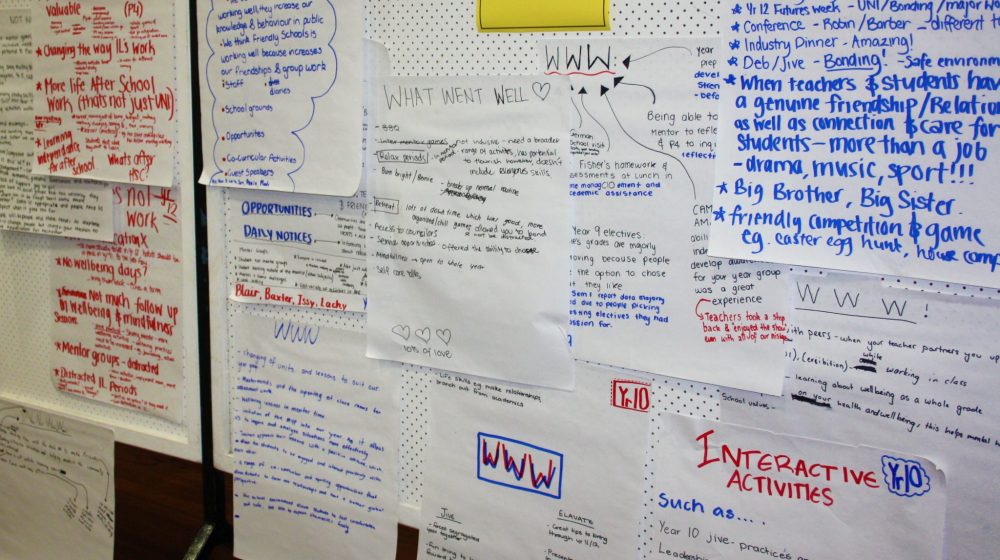Published on August 23, 2019
Student wellbeing matters. It occupies the thoughts and hearts of parents, teachers and students alike because we know that students with high levels of wellbeing feel better, can function at higher levels and perform well. Wellbeing and academic performance are inextricably linked.

Wellbeing is not something a school can ‘do to’ students and we can’t simply apply wellbeing strategies without understanding the student perspective or their lived experiences. That’s why the first HVGS Student Wellbeing Summit was held – to capture the student’s voice and activate student agency around student wellbeing and flourishing at HVGS.
Miss Samantha Ducey, Junior School Teacher and Head of Positive Education at HVGS shared more about the Student Wellbeing Summit – why it’s essential, what was insightful and what happens next.
Why is the student voice important?
Miss Ducey: Students are critical stakeholders in our community; therefore, their opinions, perspectives and experiences are essential.
By involving students in discussions about matters of importance to them, we create a community that values student opinions and perspectives. The International Baccalaureate promotes student agency and action in many forms. It encourages initiative, interest and curiosity and goal setting. When students have the opportunity to contribute to discussions relevant to them, their voice creates a sense of empowerment and motivation to create change and inspire others around them.
What was involved in the Summit?
Miss Ducey: Thirty students from Years 5 – 12 represented their grade and engaged in an Appreciative Inquiry to investigate the strengths of current approaches to student wellbeing at HVGS.
Grade and cross-grade collaboration provided a whole school approach to explore the inquiry question of ‘How can HVGS nurture thriving and flourishing students?’ The Summit created opportunities to identify current wellbeing structures and practices that already promote student wellbeing. Students also analysed what is working well and what we could adapt or change to increase student flourishing.
Finally, in a wonderful display of student agency and action, students designed proposals for generating positive change to encourage greater student flourishing in their grade.

What is Appreciative Inquiry?
Miss Ducey: Appreciative Inquiry is a systematic and collaborative change model that uses a strengths-based approach to creating positive change. This model uses appreciative based techniques to enable agency and empower a culture of inquiry, identification, solving and design of whole school practices. Research has shown that Appreciative Inquiry can be a powerful and transformative tool when used to investigate what is currently working well, in order to explore how we can build on our strengths to guide change. Appreciative Inquiry was selected as the tool to review the current wellbeing practices across the Junior School and Secondary School from the student body perspective.
Why is the HVGS focus on wellbeing essential?
Miss Ducey: As a school, we can enable our students with skills and strategies to help them understand that there are pillars of wellbeing that they can identify, build and use to help them thrive. Students with higher levels of wellbeing flourish. They demonstrate greater ability to navigate everyday challenges, show resilience when times are tough, celebrate and savour the good moments and achieve a higher level of academic success.
We can help our students flourish by assisting them in understanding that wellbeing is a multidimensional concept that can be developed intentionally through a strength-based approach and deliberate use of positive practices.
What came out of the Summit?
Miss Ducey: The Student Wellbeing Summit was a powerful tool in gathering valuable information and insight to shape positive change around a matter of importance to students. In this case, their wellbeing and how HVGS can help all students thrive.
The Summit provided important data to staff about the nature of student wellbeing at our School. It was an incredible day of inquiry, learning, positivity, connecting with peers and building relationships with students from other grades.
Students took a strengths-based approach to join forces and analyse student wellbeing from various perspectives and work towards a common goal. The Summit reinforced the high calibre of young HVGS men and women who are passionate about their School and the whole community.
What next?
Miss Ducey: The findings from the HVGS Student Wellbeing Summit have been presented to the School Executive, including student proposals for action. The school will use the data from the Summit to plan future approaches to wellbeing, based on the student voice and continued agency from the students. We’re looking forward to working alongside students to foster more opportunities to further develop their insights about wellbeing at School and how HVGS students can flourish and thrive.
Students voices
“I think my understanding of wellbeing has changed…I now have a broader concept that wellbeing is not only about being positive but about thriving as individuals and sometimes that involves overcoming challenges.”
“My hope from the Summit is that this is not the end to student engagement, but the beginning.”
“I used to think that wellbeing was only for ourselves, but I know realise we have the power to influence others wellbeing.”
“I used to think you had to lead the school to improve its wellbeing, but now I think we can achieve that through cooperation with those who lead.”
“This Summit has sparked a passion for wellbeing and I have already started to take action at home.”
